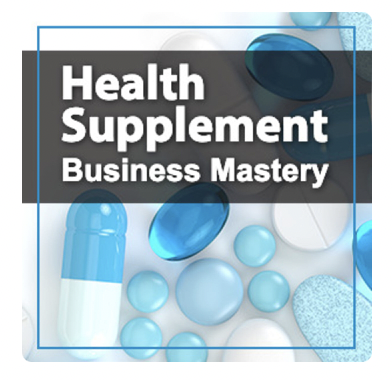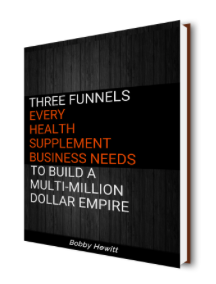A physical bridge connects two places together to get you from point A to point B.
But bridges can also connect abstract things.
Things like different ideas.
Ideas that can be used to make a marketing case for a sale.
The sale of a bottle of dietary health supplements for example, happens within the mind space of a bridge.
Bridges connect buying decision points in the mind of your prospect.
And if you facilitate the connection of them all you have a sale.
In fact, when it comes to health supplements, there are three critical bridges that you must connect to sell a bottle of dietary supplements to anyone.
Let’s look at each bridge in more detail.
The Problem Bridge
The first bridge, is called the problem bridge.
Not because it’s a problematic one but because it connects the hook to the prospects problem.
The problem is the one thing your prospect wants to solve. In the case of a health supplement it could be something like muscle soreness and recovery from exercise in your late 40’s.
The hook you bring a cold prospect in on to solve that problem could be one of many. (But the best ones are those that have a curiosity element to them.)
For example the hook to this problem might be something like:
– Sore muscles might be a sign of _____ if you’re over 40
– You can keep up with the guy half your age at the gym (if you do this one thing before every workout, especially if you’re over 40)
– The 3 best foods to eat for muscle soreness if you’re over 40
Each one of these would make good hooks to connect to the main problem.
Now that you have the problem and the hook, you’ll need to bridge the two together to lead to the next step in the sale.
How does the hook solve the problem?
How quickly you help them cross this first bridge is dependent on where your prospect is on the marketplace awareness stage. (A concept we covered in a previous article.)
If your prospect is low on the awareness pyramid.
In the compleatly unaware stage. Where your prospect is not aware of their problem or the need for a solution.
You want to cross the bridge slowly.
Building up to the connection in order to keep them on the hook longer.
It follow a structure like this:
Call out and intensify the problem (ideally with emotional sales copy).
Let them off the hook, promising a solution.
Teasing the unique mechanism behind the solution (without filling in all the answers).
Address the obvious skepticism and or any solution they think you might be hinting at.
Provide open loops along the way to keep them wanting to know more.
Finally connecting the hook to the unique mechanism of the problem where you explain the “real cause” of the problem.
Now, if your prospect is high on the awareness pyramid.
In the most aware stage. Where your prospect is aware of what you offer and how it meets their needs.
You want to cross the bridge quickly.
It’s not because they have less patience to sit through the build up in the first example, it’s because they are more aware and thus primed for a sale already.
Someone in this stage may fall into one of these categories:
They already bought from you before, i.e. a past customer on your backend marketing.
They have seen your sales letter of VSL (ideally watched 50% or more of it). This is your is typically a retargeting segment.
The previous structure could still work on this prospect stage, but a quicker structure would look like this:
Call out and intensify the problem (ideally with emotional sales copy).
Promising a solution.
Connect the hook to the unique mechanism of the problem.
Now that you’ve connected the big idea to their problem, it’s time to help the visitor cross the next chasm…
The Solution Bridge
The next bridge connects the problem to the solution.
But as in the case above where your prospect is lower on the marketplace awareness spectrum, you don’t want to directly present your product as the solution just yet.
Just like you intensified the problem, you want to do something similar to set the stage not for the solution but to the acceptance of the solution, i.e. your bottle of supplements.
One way of doing this is to present the old way and the new way.
That is, the old solution to the problem has been replaced by the new way because of a new discovery.
That new discovery is your unique mechanism of the solution.
The unique mechanism of the solution is not the product or a specific ingredient in the product but rather the way the solution works in the body.
This is the reason why your solution will work, when the others have not. Echoed again in the bridge to close, before you present your offer.
It’s the “real solution” of the problem on a high level.
And it needs to logically connect to the problem bridge.
For example: If dopamine is causing sleep loss, the solution is a new way to lower dopamine at bed time.
The solution bridge therefore connects the high level solution to the detail level.
Of course this needs to be backed up with credibility and proof elements along the journey across the bridge.
If the first bridge was about emotion, this bridge is about logic.
The next bridge will begin the sale.
The Selling Bridge
The third bridge is the final bridge a visitor needs to cross in order to buy.
It’s the selling bridge to the offer.
And it all starts with first asking permission to sell.
Asking permission for the sale is different than presenting the offer.
The offer, call to action, what they get, guarantee, testimonials, bonuses and all that comes after asking for permission to sell.
Permission to sell is all about how they will feel after using your product. This builds up the value of the product. Through the unique mechanism and also testimonials.
It sets the stage and future paces the purchase before presenting the offer.
It could also dismiss other alternatives and tell the reader how to use the product. But that is typically an optional section.
In addition to creating some urgency. For supplements that’s typically around the scarcity of the ingredients or the product itself from high demand.
At this stage the personal mission of the founder can come back in calling back to the early part of the sales letter in which the speaker is introduced. Typically at the “Hi my name is” part.
This ties back to the core emotion and creates a sense of if you’re like me or if you agree with this mission then here’s the product you need to support your belief.
Then finally comes the product details. (What’s included, and for how much, price justification, guarantee, etc.
Followed by the summary of the offer itself, presenting the actual options. Typically a choice between 1, 3, and 6 bottles.
But the selling is not over just yet.
This is where more testimonials can be stacked for further social proof and or a list of the frequently asked questions about the product.
A final P.S. in which a list ditch close effort and urgency come back into play.
See You On The Other Side
Congratulations, we’ve crossed all three bridges and made a sale.
Here’s a quick recap:
The problem bridge connects your big idea to the problem. It’s that payoff.
The solution bridge connects the problem to the solution.
And finally the selling bridge connects the solution to the offer leading to the sale.
Leading with future pacing how they will feel after using your product. And finally to the call to action, what they get, guarantee, testimonials, bonuses, etc.
Once the customer crosses all three bridges, they are finally ready to buy a bottle of supplements.
Discover the 3 funnels that can help your health supplement business succeed.

Listen to the Health Supplement Business Mastery Podcast for for dietary supplement entrepreneurs and marketers.



